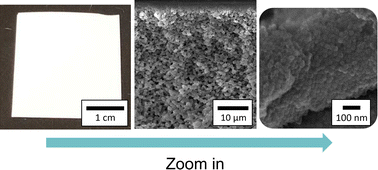Bicontinuous interfacially jammed emulsion gels with nearly uniform sub-micrometer domains via regulated co-solvent removal†
Abstract
Porous materials possess numerous useful functions because of their high surface area and ability to modulate the transport of heat, mass, fluids, and electromagnetic waves. Unlike highly ordered structures, disordered porous structures offer the advantages of ease of fabrication and high fault tolerance. Bicontinuous interfacially jammed emulsion gels (bijels) are kinetically trapped disordered biphasic materials that can be converted to porous materials with tunable features. Current methods of bijel fabrication result in domains that are micrometers or larger, and non-uniform in size, limiting their surface area, mechanical strength, and interaction with electromagnetic waves. In this work, scalable synthesis of bijels with uniform and sub-micrometer domains is achieved via a two-step solvent removal process. The resulting bijels are characterized quantitatively to verify the uniformity and sub-micrometer scale of the domains. Moreover, these bijels have structures that resemble the microstructure of the scale of the white beetle Cyphochilus. We find that such bijel films with relatively small thicknesses (<150 μm) exhibit strong solar reflectance as well as high brightness and whiteness in the visible range. Considering their scalability in manufacturing, we believe that VIPS-STRIPS bijels have great potential in large-scale applications including passive cooling, solar cells, and light emitting diodes (LEDs).



 Please wait while we load your content...
Please wait while we load your content...